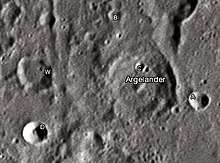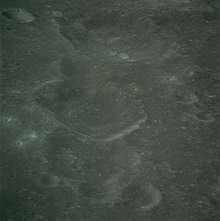Argelander (crater)
Argelander is a lunar impact crater that is located in the south-central highlands of the Moon. It was named after the German astronomer Friedrich Argelander.[1] It lies in the midpoint between the smaller crater Vogel in the north and the larger Airy to the south. To the northwest is the worn remnant of Parrot. Just to the west is a shallow cleft in the surface that follows a course to the north-northwest, intersecting the southeast rim of Parrot.
 LRO WAC mosaic | |
| Coordinates | 16.5°S 5.8°E |
|---|---|
| Diameter | 34 km |
| Depth | 3.0 km |
| Colongitude | 354° at sunrise |
| Eponym | Friedrich Argelander |
The rim of Argelander is somewhat worn and indented, although less distorted than Airy to the south. The bottom is relatively flat and there is a small central rise. There is a curved depression in the surface following the western rim, giving the wall a rampart on that side.
Satellite craters
By convention these features are identified on lunar maps by placing the letter on the side of the crater midpoint that is closest to Argelander.

| Argelander | Latitude | Longitude | Diameter |
|---|---|---|---|
| A | 16.5° S | 6.8° E | 9 km |
| B | 15.5° S | 5.1° E | 6 km |
| C | 16.3° S | 5.7° E | 4 km |
| D | 17.6° S | 4.4° E | 11 km |
| W | 16.7° S | 4.2° E | 19 km |
References
- "Argelander (crater)". Gazetteer of Planetary Nomenclature. USGS Astrogeology Research Program.
- Andersson, L. E.; Whitaker, E. A. (1982). NASA Catalogue of Lunar Nomenclature. NASA RP-1097.CS1 maint: ref=harv (link)
- Bussey, B.; Spudis, P. (2004). The Clementine Atlas of the Moon. New York: Cambridge University Press. ISBN 978-0-521-81528-4.CS1 maint: ref=harv (link)
- Cocks, Elijah E.; Cocks, Josiah C. (1995). Who's Who on the Moon: A Biographical Dictionary of Lunar Nomenclature. Tudor Publishers. ISBN 978-0-936389-27-1.CS1 maint: ref=harv (link)
- McDowell, Jonathan (July 15, 2007). "Lunar Nomenclature". Jonathan's Space Report. Retrieved 2007-10-24.CS1 maint: ref=harv (link)
- Menzel, D. H.; Minnaert, M.; Levin, B.; Dollfus, A.; Bell, B. (1971). "Report on Lunar Nomenclature by the Working Group of Commission 17 of the IAU". Space Science Reviews. 12 (2): 136–186. Bibcode:1971SSRv...12..136M. doi:10.1007/BF00171763.CS1 maint: ref=harv (link)
- Moore, Patrick (2001). On the Moon. Sterling Publishing Co. ISBN 978-0-304-35469-6.CS1 maint: ref=harv (link)
- Price, Fred W. (1988). The Moon Observer's Handbook. Cambridge University Press. ISBN 978-0-521-33500-3.CS1 maint: ref=harv (link)
- Rükl, Antonín (1990). Atlas of the Moon. Kalmbach Books. ISBN 978-0-913135-17-4.CS1 maint: ref=harv (link)
- Webb, Rev. T. W. (1962). Celestial Objects for Common Telescopes (6th revised ed.). Dover. ISBN 978-0-486-20917-3.CS1 maint: ref=harv (link)
- Whitaker, Ewen A. (1999). Mapping and Naming the Moon. Cambridge University Press. ISBN 978-0-521-62248-6.CS1 maint: ref=harv (link)
- Wlasuk, Peter T. (2000). Observing the Moon. Springer. ISBN 978-1-85233-193-1.CS1 maint: ref=harv (link)
External links
- Argelander at The Moon Wiki


